AARP Hearing Center
By Craig Welch
Photographs by Jesse Rieser
As more older Americans move to the coasts, rising seas are wiping out their homes — and retirement dreams.
Debris of the Fort Myers Beach Fishing Pier in Florida, destroyed by Hurricane Ian in September 2022
By Craig Welch
Photographs by Jesse Rieser
Martha Shaw was ready. As forecasters in September 2022 warned of a storm bearing down on Florida’s Gulf Coast, she grabbed a blanket and her cane, stuffed a suitcase with clothes and loaded a kennel for her toy poodle, Andre, into her silver SUV. Shaw, who had just turned 84, had been through this before. Hurricane Charley in 2004 had damaged the roof and siding on her mobile home in Fort Myers. But inside, everything had stayed dry.
This time, Shaw planned to drive inland to a rest stop on Interstate 75, sleep in her car and return the following morning. But as warnings about Hurricane Ian grew more dire, she realized her plan was unsafe. In the pelting rain, she drove instead to an emergency shelter lined with cots and watched out a window as the Category 4 monster raged.
Ian’s storm surge pushed water inland from the Gulf of Mexico, flooding coastal areas including Fort Myers. Joe Guerra/TMX/Getty Images UGC
Ian’s winds approached 150 miles per hour, churning up a massive 14-foot storm surge. Water roared inland. Flooding overtopped houses, crumpled bridges and drove boats across roadways. More than 60 people drowned in the storm — some in their cars, others in their attics. Watching a small part of this disaster unfold, Shaw felt she was floating outside her body. “I was numb, in limbo,” she later told me, her voice cracking. “I didn’t know how to feel.”

A resident of Sunshine Mobile Village in Fort Myers captured this view of Ian’s floodwaters. Courtesy Barbara Verity
When the skies finally cleared and a friend drove Shaw back to the plot she owned at Sunshine Mobile Village, Shaw couldn’t believe her eyes. Half a mile inland from Fort Myers Beach, Ian had pushed fetid water nearly to her ceiling. The place was uninhabitable.
I met Shaw, 85, last September, a year to the day after Ian hit. I liked her immediately. She’s tall and funny, with an open smile, a big laugh and the quiet confidence of someone who spent her career ruling elementary school classrooms. When I asked about the storm, she sobbed briefly, so I apologized. “Oh, you didn’t upset me,” she said, graciously. “I mean, that’s how it hits me: in a little wave.”

Retired schoolteacher Martha Shaw at the site of her former residence
Stories like Shaw’s have always been part of living in coastal areas. But today those stories are growing more common, especially for people over 50. Flooding of all kinds is increasing along much of the nation’s shoreline. Due to rising sea levels tied to climate change, high-tide “nuisance” flooding now occurs three to nine times more often than it did 50 years ago, according to the National Oceanic and Atmospheric Administration (NOAA). At the same time, hurricanes are getting stronger, bringing more rain and creating surges that push farther inland than ever. This means more damaged property, more shattered and lost lives.
And increasingly, the people in harm’s way are older. Between 1970 and 2022, the number of people over 65 living in counties along the country’s East, West, Gulf and Great Lakes coasts rose 159 percent. Over the same period, the percentage of younger people living in those areas actually dropped.
Water doesn’t discriminate by age, of course. In the devastating floods that hit Southern California in February — caused by a record-setting “atmospheric river” of rain — people of all ages lost power, lost their homes. Nine lost their lives. But the impact of flooding specifically on older people is “often underappreciated,” says Anamaria Bukvic, a Virginia Tech assistant professor who studies that impact. Even minor floods can be disastrous for this population, preventing access to food, medicine or emergency care; shutting off power, heat or air-conditioning; or draining limited savings. People with mobility or cognitive issues may live in dwellings not designed for big floods. Some people can’t — or won’t — evacuate. If they do, relocation may trigger anxiety and loneliness.
“Their whole world is often right in their home — that’s their whole life,” says Erin McLeod, who runs Senior Friendship Centers in Southwest Florida. “And they wonder: If they leave, will they be able to get back? Will that home still be there?”
Fort Myers Beach, located on a barrier island, is still recovering from the 2022 storm.
As a journalist who specializes in climate reporting, I’ve tracked our changing planet for much of my adult life. Over decades, I’ve seen scientists fine-tune their ability to link emissions from the burning of coal, oil and natural gas to the changes we see all around us, including flooding. Not everyone is comfortable with this, but the evidence keeps growing stronger. Last year was the Earth’s warmest since NOAA’s recordkeeping began in 1850, and the last 10 years were the warmest 10 on record.
The Sunshine State has one of the country’s highest percentages of citizens over 65 — and 1.8 million properties facing substantial flood risks.
I know the damage this change has wrought. In 2017, just weeks after Hurricane Harvey dumped up to 40 inches of rain on Houston, several of the nation’s top experts told me that excess warmth had increased Harvey’s torrential rains. Since then, NOAA scientists have published research highlighting another factor: Thanks to atmospheric warming, tropical cyclones, including Harvey, have been moving more slowly since the 1950s, allowing them to linger longer and deliver more punishing blows. Research also showed that up to half of the 106,000 properties damaged by Harvey’s floods would have been spared if the climate had not been changing.
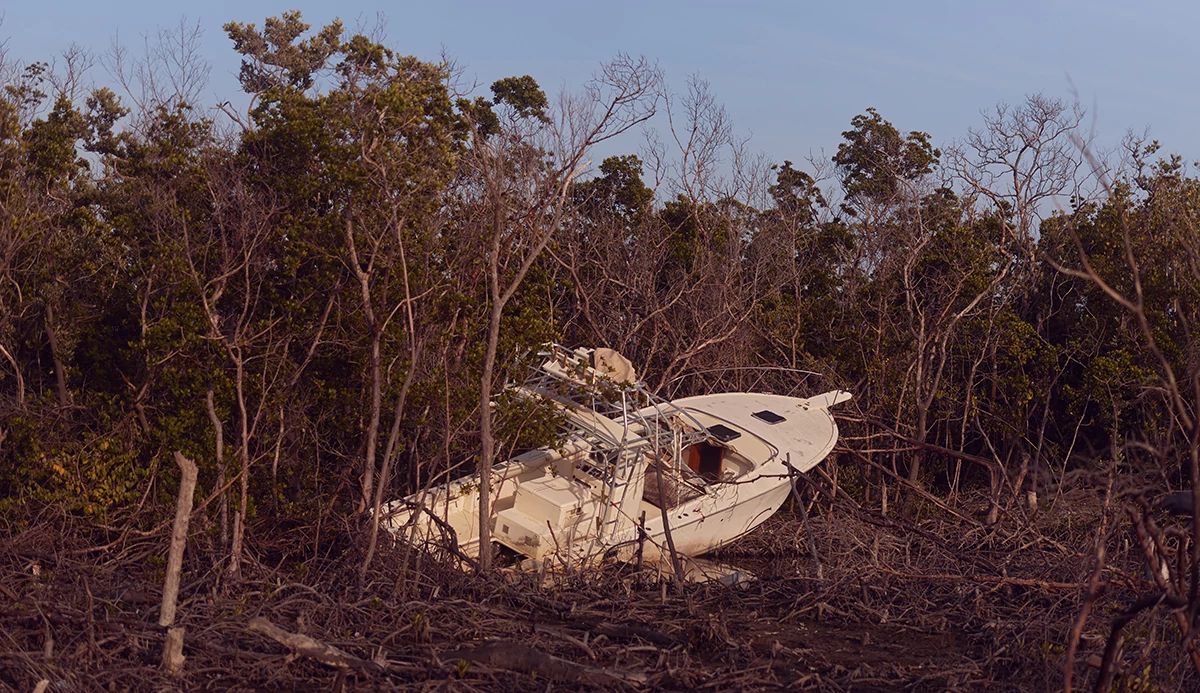
More than 18 months after Hurricane Ian, debris like this disabled boat is still in evidence.
So, wanting to understand the burdens hitting older people on the coasts, I made my way to two of the hardest-hit regions in this nation: New Jersey and Florida’s Gulf Coast.
In five counties across New Jersey, at least half of people 65 and older live in flood zones. In Cape May, one Category 2 hurricane could be enough to flood half of older residents’ homes.
The Sunshine State, on the other hand, has one of the country’s highest percentages of citizens over 65 — and 1.8 million properties facing “substantial” flood risks. Fully 99 percent of dwellings in Naples, for example, have a 1 in 4 shot at being flooded during the span of a traditional mortgage.
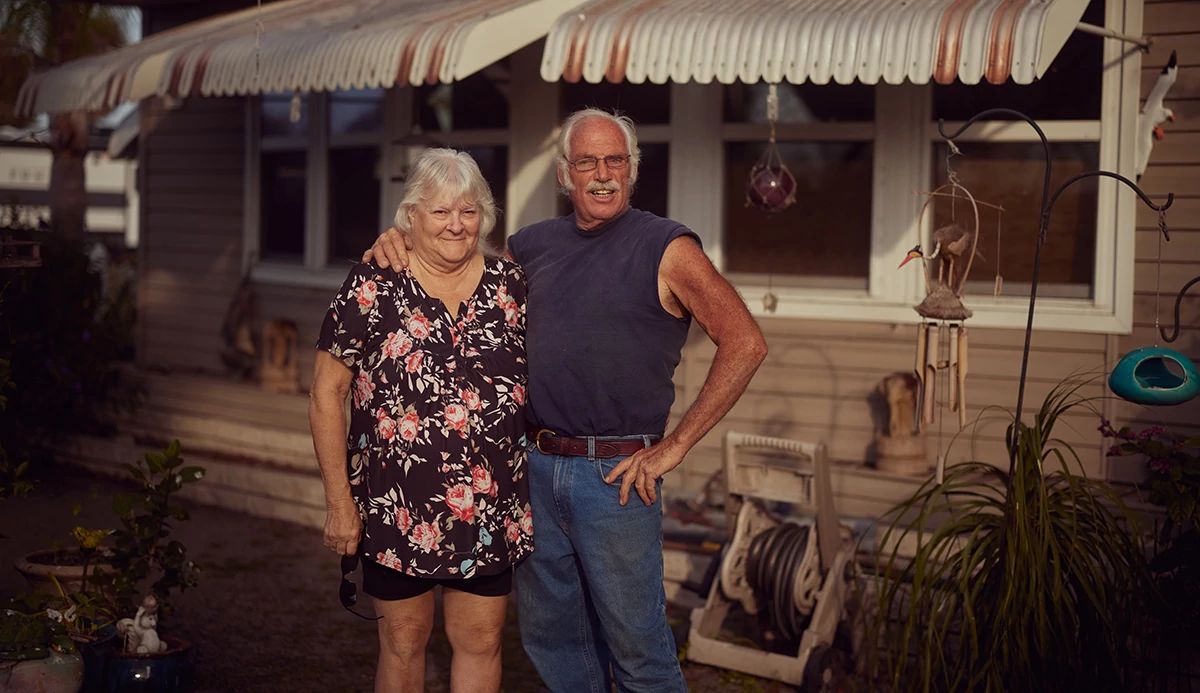
Shaw’s neighbors Barbara and Dave Verity are in the process of rebuilding their home at ground level.
That danger is only growing. Every major scientific body, from NOAA to the United Nations’ Intergovernmental Panel on Climate Change, has concluded that flooding risks will keep ticking up. As polar ice caps in Greenland and Antarctica melt, for example, and oceans absorb heat and expand, global sea levels have risen at least 8 inches since the 1880s. Roughly half of that increase has come since the early 1990s. And that rate is accelerating.
A few inches of sea level rise may not sound like much, but those few extra inches can make rivers overflow their banks, levees give way, or floodwaters enter a business or home. Just look at Charleston, South Carolina. Through the 20th century, Charleston faced at most 35 floods a year. But coastal waters there have risen more than the global average, and in 2019 the city saw 89 floods. “When I moved here 20 years ago, no one was talking about climate change or sea level rise,” says resident Susan Lyons, 80.
But in 2015, monster rains and an extra-high “king” tide let 3 feet of water pool in the crawl space under Lyons’ house, which is two blocks from the Ashley River and eight from Charleston Harbor. She spent thousands of dollars fixing duct work. Floods returned in 2016 and 2017, when Lyons helped to found a grassroots local group to press city officials to take flooding seriously. As her group pushes for drainage improvements and other flood preparations, she says, “I’m just a senior anxiously waiting for the next storm.”

The Veritys’ bedroom was still a work in progress in March of this year.
Martha Shaw surveyed the damage after Hurricane Ian. Her home looked like a dollhouse ransacked by an angry child. An oak spinet piano was flipped on its back. Floodwaters had ripped the mattress from her bed, tipped over bookshelves and crushed her jewelry box. Her heavy drop-leaf dining table had floated into her living room. A muddy waterline smeared a print of the Madonna hanging on a wall.
Sunshine Mobile Village in March 2024; many destroyed homes have been cleared and not yet rebuilt.
Shaw was shattered. She felt she’d done everything right. As a teacher in San Bernardino, California, she’d been careful with her money, so when she retired in 2002, she was able to move to Florida and pay cash for her home. She was a single woman, living alone, but she knew where everything was — her puzzles, her Christmas ornaments, her Hummel figurines. Every morning, she and Andre would meet two neighbors and their dogs, Otis and Rocco, near a bench by a tree. It had been a terrific life, but it seemed to be over.
The days that followed came as such a blur that Shaw felt as if they were happening to someone else. A nephew and volunteers came by and saved what they could, including figurines and a few clothes, which she salvaged by scrubbing them with vinegar and dish detergent. But most of Shaw’s pants and blouses looked and smelled as if they’d been stored for weeks in a ditch. She tossed them, along with her furniture. Looters made off with her generator, her mother’s silver— and an engraved pistol her father, a highway patrolman, had received as an award for valor.
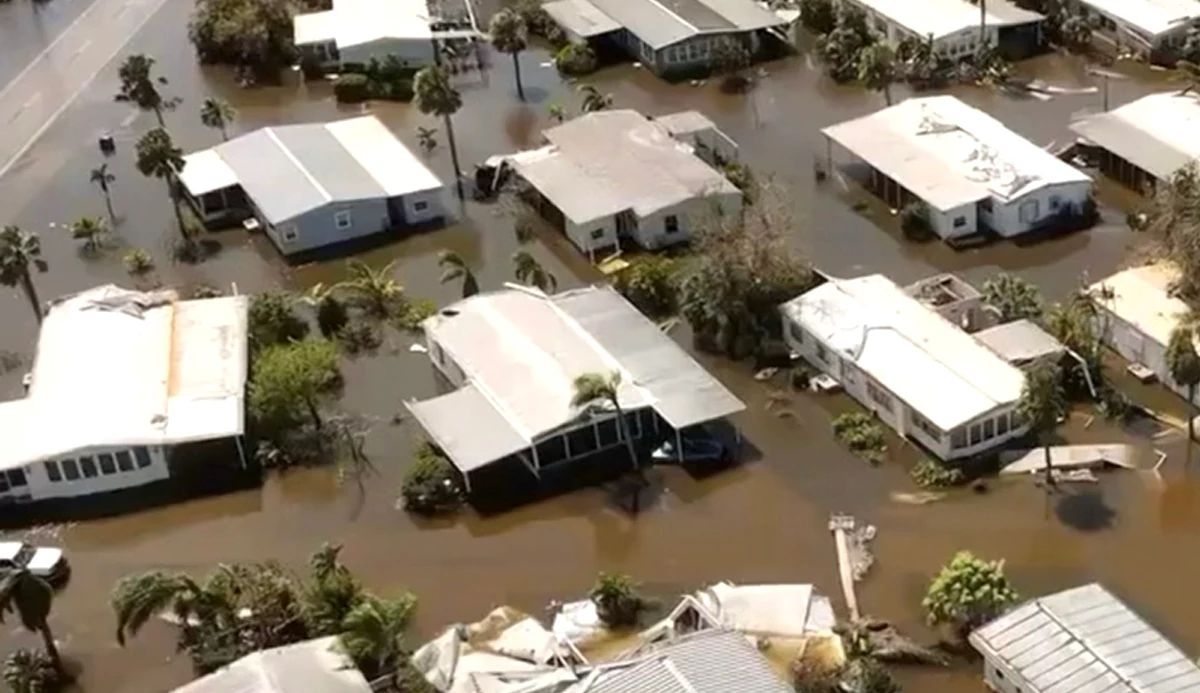

Sunshine Mobile Village shortly after the storm; the waterline in Shaw’s living room cuts through framed artwork on the walls.
Within weeks it became clear that Shaw’s home could not be saved. She couldn’t even step all the way inside the house; the carpet was too dangerously slick for her unsteady legs. Below the carpet, the floorboards were weak and waterlogged — neighbors feared they’d collapse. Mold had taken root and smelled so vile and toxic that Shaw wore two COVID-19 masks, even in the doorway.
It didn’t take long for panic to set in. Shaw was paid up on her homeowners insurance, but it didn’t cover floods. Since water had never entered her home before, even during previous hurricanes, she’d let the flood policy lapse. That’s not uncommon, especially because the cost of flood insurance has been going up. The Federal Emergency Management Agency (FEMA), through which most people buy flood insurance, is in debt to the U.S. Treasury from paying out claims. So, under pressure from Congress, the agency has raised rates to better reflect the costs of flood damage claims. That has driven hundreds of thousands of homeowners to drop coverage, according to a 2022 analysis by Politico’s E&E News. In fact, less than one-third of the 1.8 million households in counties in Ian’s path had flood insurance at all.
CONTENT CONTINUES AFTER ADVERTISEMENT
Shaw was eligible for some assistance from FEMA, but not enough to rebuild her home. Like thousands in Southwest Florida, she was stuck. Volunteer crews moved her to a huge new shelter inside an old Sears store, but she had to house Andre with the other pets at the building’s far end. Shaw could visit him only when an aide found a wheelchair and the time to push her there.
She learned that rules to protect homeowners during future floods meant any new building in Sunshine Mobile Village would need to be elevated. Given her cane, that meant adding an expensive elevator. Even with homeowners insurance — which paid for the wind damage but not the water damage — and grants, she’d need a mortgage and, during construction, a place to live, for which she’d owe rent. It slowly dawned on Shaw that if she rebuilt, she’d be out hundreds of thousands of dollars for a life that weeks earlier had cost her almost nothing. She felt overwhelmed. By late fall of 2022, workers at the shelter were trying to nudge her into assisted living, but she didn’t want to live in a group setting. Shaw considered living in her car. Even if her place was gone, this area was still her home. Where else was she supposed to go?
Shaw could feel herself shutting down and giving up. All day at the shelter, she sat and did puzzles. Then one day, she recalls, “I finally said, ‘You’ve got to get out of the chair. ’ ”

Joe Prigun sits on the site of his former home. Prigun had hoped to fix flood damage from Hurricane Ian himself.
Not far from Shaw’s old neighborhood, Joe Prigun had tried riding out Ian at home. He’d quickly found himself standing on a bathroom sink, neck-deep in rising water, worried about running out of air. He escaped through a window and huddled on his roof until rescue crews zipped by in an airboat. When we spoke last September, a year later, he was living in an apartment in a former Ramada Inn that FEMA had rented for flood survivors.


Prigun’s home was damaged beyond repair and had to be demolished; he is now living in a hotel room provided by FEMA.Courtesy Joe Prigun; Jesse Rieser
Prigun had been trying repair his home because he knew FEMA wouldn’t let him stay at the hotel forever. Since he’s on a fixed income, and reputable contractors had more lucrative options than taking on clients for whom money’s tight — “the good ones don’t want to hear that, when they can be working on million-dollar homes,” he told me — he was doing much of the work himself. But at 71 he can’t do what he once could. “I’m not going to get up on a ladder or on a roof,” he says. “There’s a limit.” After we spoke, though, Lee County determined that the house had been too damaged by the storm to save and ordered it demolished.
I met Jose Guzman, 71, in Fort Myers’ Harlem Heights neighborhood while he cooked dinner on a charcoal grill in his carport. Guzman had been living in his low-slung ’80s ranch home for a quarter century. Four miles from the coast and a mile and a half from the Caloosahatchee River, he, too, had never once been flooded — until Ian. The 2022 storm filled Guzman’s house to his thighs and turned his neighborhood into a lake. He opened the front door and showed me inside. A year later, his furniture was still pushed into a circle in the middle of the living room as he slowly repaired the floors and walls.

Jose Guzman had lived in the Harlem Heights neighborhood in Fort Myers for 25 years before he experienced his first flood.
Danielle Lisiecki, 61, also thought she had life figured out. She had taught nursing at a community college outside Chicago until retiring in May of 2022. She and her husband, Mike, 64, paid cash for their dream retirement home on a Cape Coral lot on the Caloosahatchee. Lisiecki and her husband had saved and invested well; a financial planner had calculated that they could live 40 more years without running out of money.
During Ian, 150-mile-per-hour wind gusts and just 6 inches of floodwater upturned their lives. The water destroyed the drywall, flooring and electrical system in the Lisieckis’ home. The repairs cost more than half of the structure’s value, triggering rules requiring the 45-year-old house to meet new building standards, which would require elevating the home. “It’s a complete teardown,” a furious Lisiecki told me. Before Ian, she’d been happily adapting to the rhythms of life on a fixed income. By 2023, with a temporary rental and a new mortgage, she was back to working again.
CONTENT CONTINUES AFTER ADVERTISEMENT
Still, in real ways, the Lisieckis were lucky. The vast majority of the 150 Floridians who perished because of the hurricane were over 65, many because they lost access to supplemental oxygen or kidney dialysis machines. Untold numbers of Ian victims still lived in their cars more than a year later. As of January 2023, homelessness was up 70 percent from the year before in Fort Myers’ Lee and neighboring Collier and Charlotte counties. Even a year and a half after the storm, a residential community in Cape Coral that was once home to 132 members, many of them older adults , would be down to 82. “We still have 50 residents homeless or living with family, or living on the couches of friends,” one of them told a local television station. Martha Shaw’s two closest friends were forced to move away.
Twelve hundred miles to the north, Jody Stewart intends never again to be surprised by a storm. When I visited coastal New Jersey, Stewart took me for a ride in her red Corolla, motoring around Little Egg Harbor, a marshy, working-class township of homes backed up to canals, north of Atlantic City’s glittering skyline. Stewart, 66, is pint-size and frenetic, with an ex-smoker’s rasp and a former bartender’s wizened charm. She wanted to show me how much had changed since Superstorm Sandy swamped this region in 2012. But she kept interrupting her train of thought with angry outbursts about what she saw around us.
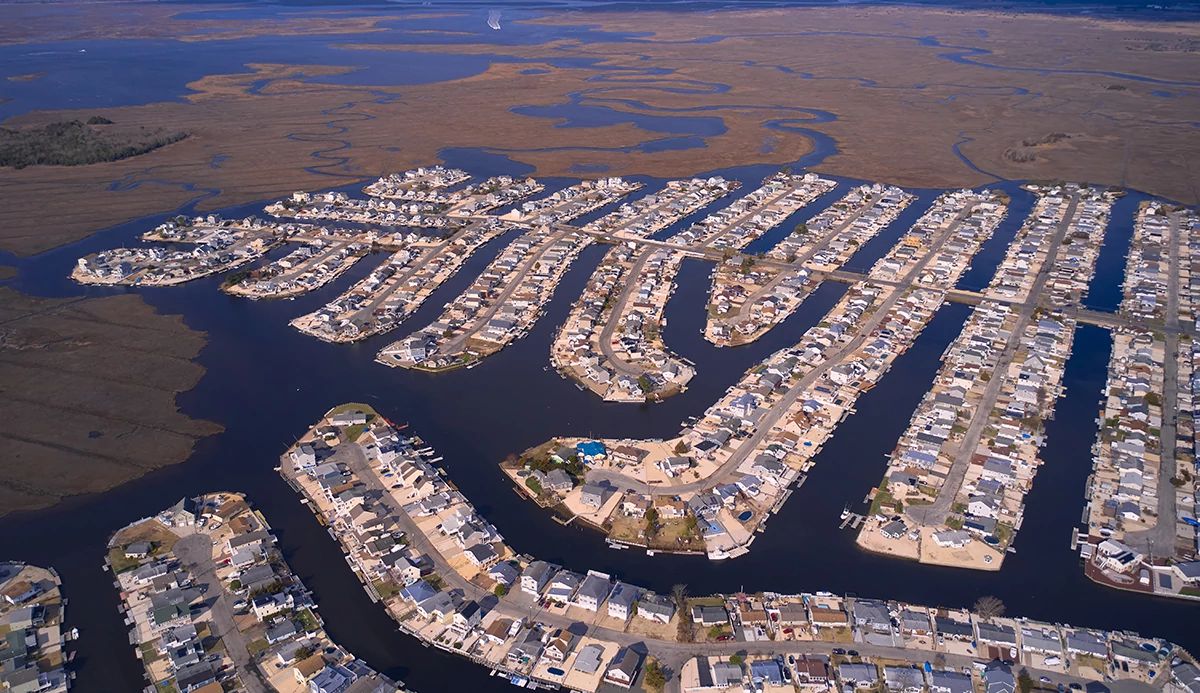
Mystic Island is defined by canals that residents use for boats.
Stewart’s husband, Bill, 73, a builder, had bought their bungalow here in Mystic Island in 1996 for $52,000; he and Stewart married in 2002. She sold bait and tackle — live minnows and crab — at the local marina and made extra money cleaning houses. Their home had been their nest egg. “Our plan had always been to retire, sell it and move away,” she says. Stewart had flood insurance but wasn’t prepared for Sandy, which hit one October night in 2012. Floodwaters peaked at 43 inches in her living room. All of her furniture save one antique was destroyed. Silt from the sea coated every surface. “I remember the horror of seeing the bottom of the ocean everywhere — even on my kitchen countertops,” she says.
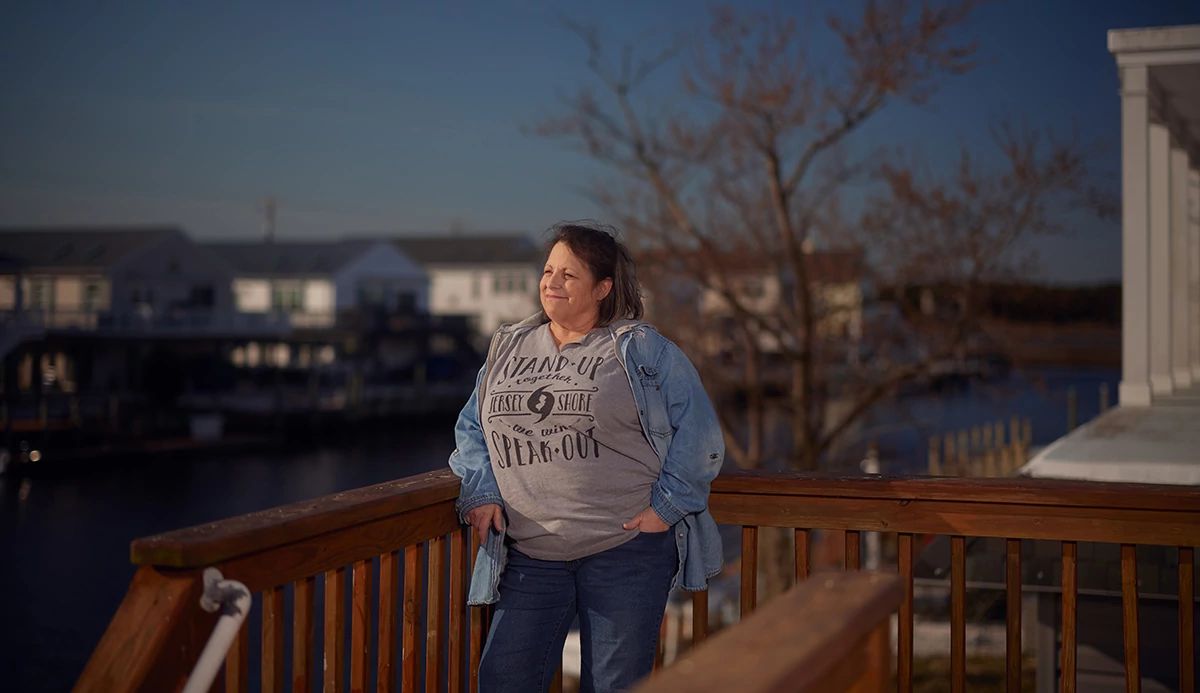
Jody Stewart at the Little Egg Harbor Township, New Jersey, home she shares with her husband
Those, like Stewart, who saw more than half of their home’s value wiped out were required to elevate their structures to avoid future floods. But many who had slightly less damage just fixed things up and sold. Post-flood, the real estate market had exploded, for elevated and ground-level properties alike.
On every street during our drive, Stewart pointed out houses on pilings, a dozen feet off the ground, right next to spiffed-up bungalows still flush with the pavement. A real estate website listed one cute 780-square-foot ground-level cottage at $375,000. “Yeah, figure that one out,” Stewart smirked. Another had been bought by a retiree who told her that Mystic Island would never flood again. “Good luck, then,” she said, with a dismissive wave. “Everyone wants to live at the shore, and they want to own a home.”
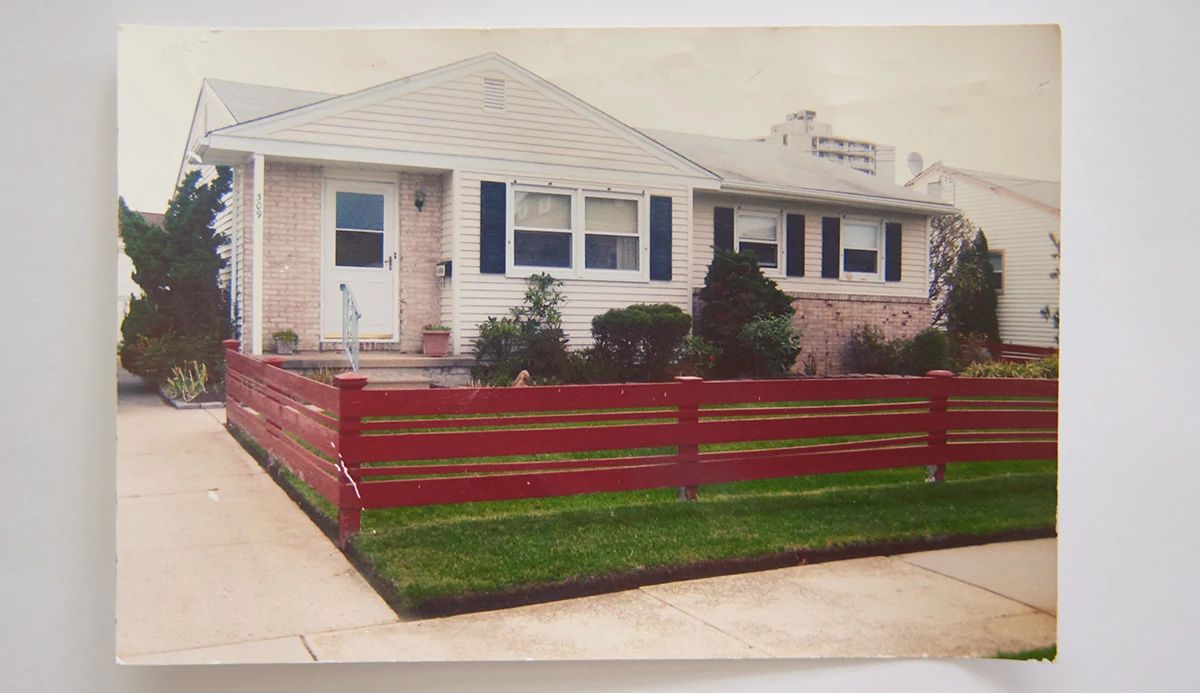

The home of Fran Baronowitz of Ventnor City, New Jersey, was flooded during Superstorm Sandy in 2012; she rebuilt it at a higher level to prevent flooding.
Instead of retiring, Stewart now works to pay the bills she accumulated rebuilding her life. As a staff member with the New Jersey Organizing Project, she helps other flood victims from around the country unravel the bureaucracy they confront after disasters. But to her dismay, Stewart may now be better positioned to move than ever: The value of her home has ballooned. She’s struggling to decide what to do. “Part of me still really wants to leave,” she confides. “Morally, I wonder, though, How could I sell this house and let someone else go through this?”
Stewart has earned her skepticism. Two days before our drive, I’d taken an elevator several stories up to a grassy patio amid the sparkling glass of Atlantic City’s Ocean Casino Resort. Kimberly McKenna, interim executive director of Stockton University’s Coastal Research Center, had been helping me understand the region’s flooding problems. Atlantic City sits on a barrier island, Absecon, and has battled water for a century by dredging canals, reworking drainage systems, adding sand to beaches and building up bulkheads. But the city has never fully mastered the situation.
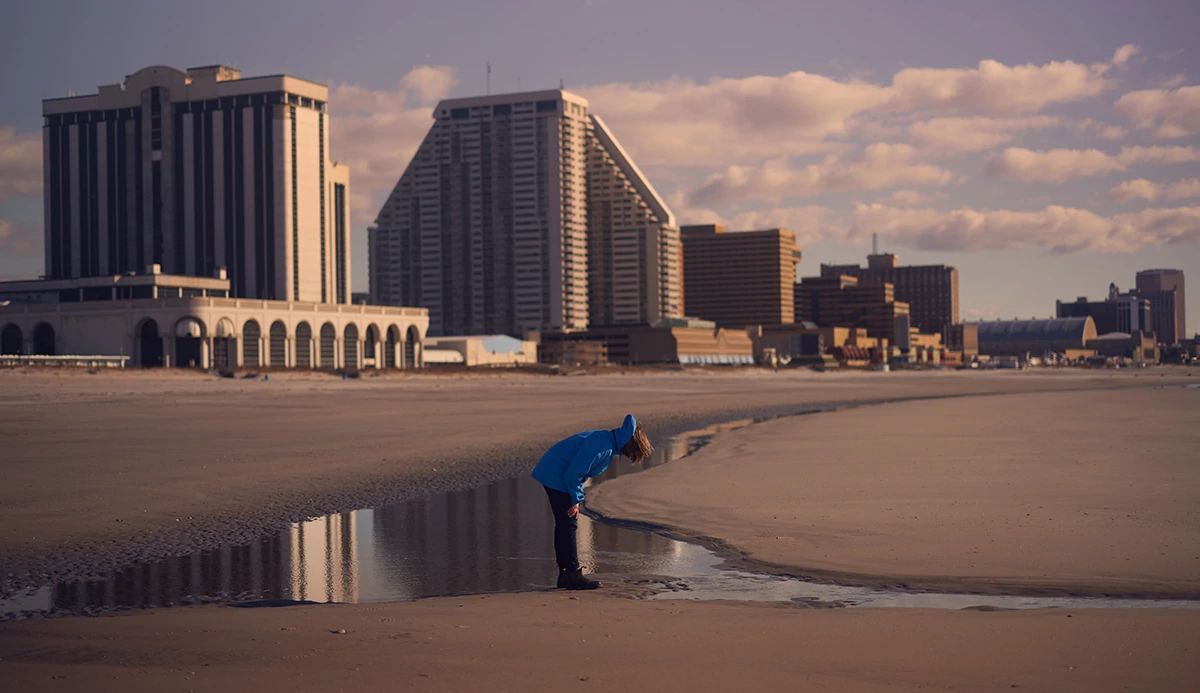
Kimberly McKenna, interim executive director of Stockton University’s Coastal Research Center, inspects a tide pool in Atlantic City, New Jersey.
McKenna nodded toward the boardwalk at one of the region’s oldest landmarks — a steel pier packed with amusement park attractions. Below it was an instrument that helped explain why the city can’t get out ahead of its water problems: a tide gauge. Installed a dozen years after the pier opened in 1898, the gauge has helped researchers track sea levels as they’ve risen at twice the national average. (In part that’s because land here has been sinking since the last ice age.)
The impacts are noticeable. The nonprofit communications group Climate Central reported that roughly $8 billion of Sandy’s $62.7 billion in damages incurred in New Jersey, New York and Connecticut could be attributed to the portion of sea level rise brought about by warming temperatures. Those changes helped surge-driven floodwaters reach 71,000 more people. Nuisance floods in Atlantic City, which came less than once a year in the 1950s, now happen, on average, eight times annually. Rutgers University researchers project that in 2030, the area could see up to 75 days a year of flooding. Jacques Howard, Atlantic City’s director of planning and development, wrestles with these issues regularly. A state government program called Blue Acres has bought and destroyed 1,100 repeatedly flooded homes statewide, including 18 in a community adjacent to Atlantic City. But city officials aren’t “all that enthusiastic” about the prospect of flood-prone properties being demolished, Howard told me. The city is $375 million in debt. “When we lose properties, we lose a percentage of our tax base,” he says. And that leaves less money in the coffers to clean up the mess after the next big storm — a storm Howard knows is coming.

Michael Savarese, professor of coastal geology, climate resilience and preparation at Florida Gulf Coast University, took our reporter on a tour of Hurricane Ian damage.
What does all this mean for older Americans who have spent their lives in coastal areas — or who may be dreaming of a seaside retirement? It means facing the reality that floods are in their future.
What AARP Is Doing

When a storm is looming: AARP’s state offices are able to quickly reach members with critical warnings and safety information. Our offices can also help local governments consider the needs of older adults, including those in residential care settings, in the lead-up to a storm.
What AARP Is Doing

In the aftermath: AARP helps with immediate and long-term relief efforts. After Hurricane Maria hit Puerto Rico in 2017, staff and volunteers distributed more than 7,000 bags of groceries to older people in the affected areas. And when Hurricane Ida struck Louisiana in 2021, AARP Foundation granted more than $1 million to local relief organizations serving older adults.
What AARP Is Doing

During ongoing recovery: AARP’s Community Challenge grants fund local projects to restore flood-damaged areas, among other projects, and prepare for future emergencies. In Gulfport, Mississippi, for example, three grants have helped reclaim and revitalize areas that were devastated by Hurricane Katrina in 2005.
What AARP Is Doing

Before the next one: AARP’s policy team works at the national, state and local levels to advocate for increased disaster preparedness, such as ensuring that long-term care facilities have generators. The AARP Disaster Resilience Tool Kit for local leaders outlines steps community leaders can take to be prepared — and to qualify quickly for FEMA funds when a significant weather event occurs.
Michael Savarese, a professor of coastal geology, climate resilience and preparation at Florida Gulf Coast University, spent one morning showing me Hurricane Ian’s path. We toured Sanibel Island, where waves had washed onto the second story of beachfront condos. We drove through working-class Dunbar, a dozen miles from the coast but adjacent to the Caloosahatchee River. There, even one year later, some homes had furniture stacked outside.
When Savarese pulled onto Estero Boulevard in Fort Myers Beach, Ian’s legacy was overpowering. In between open-air restaurants and construction crews rebuilding motels, lot after lot of waterfront properties sat vacant, some piled with gravel and cement rubble, most cleared to their sand-strewn foundations. Flapping tarps exposed kitchen appliances in gutted pastel-colored homes. “So that’s what’s left of the pier there,” Savarese said, waving at a row of concrete pilings stretching into the water.

Driving along Estero Boulevard in Fort Myers Beach in March
And yet people still want to move here — perhaps, in part, because the public isn’t always given clear information about what’s at stake. More than one-third of U.S. states, including Florida, don’t require flood history disclosure in real estate sales. (New Jersey was another, until the state passed a law in 2023.) Nationally, maps identifying at-risk regions are out of date, don’t account for intense rains and haven’t kept up with climate threats. Nearly 6 million properties nationwide face legitimate flood dangers not identified on official documents, according to an analysis by the First Street Foundation. FEMA itself conceded that Hurricane Ian’s floodwaters “extended far beyond” mapped areas and exceeded projected heights by several feet. Property owners need not live in flood zones to buy coverage, though without a designation, they’d have little reason to suspect they might need it.
Sooner or later, though, we’ll all face consequences. Damage costs from hurricanes and floods after storm surges are projected to grow faster than the U.S. economy, increasing up to eightfold by 2075, according to an estimate by the Congressional Budget Office. Research last year led by economists at the nonprofit Environmental Defense Fund suggested that American homes at risk of flooding already are overvalued by $121 billion to $237 billion. (Scientists have dubbed it the “flood bubble.”)
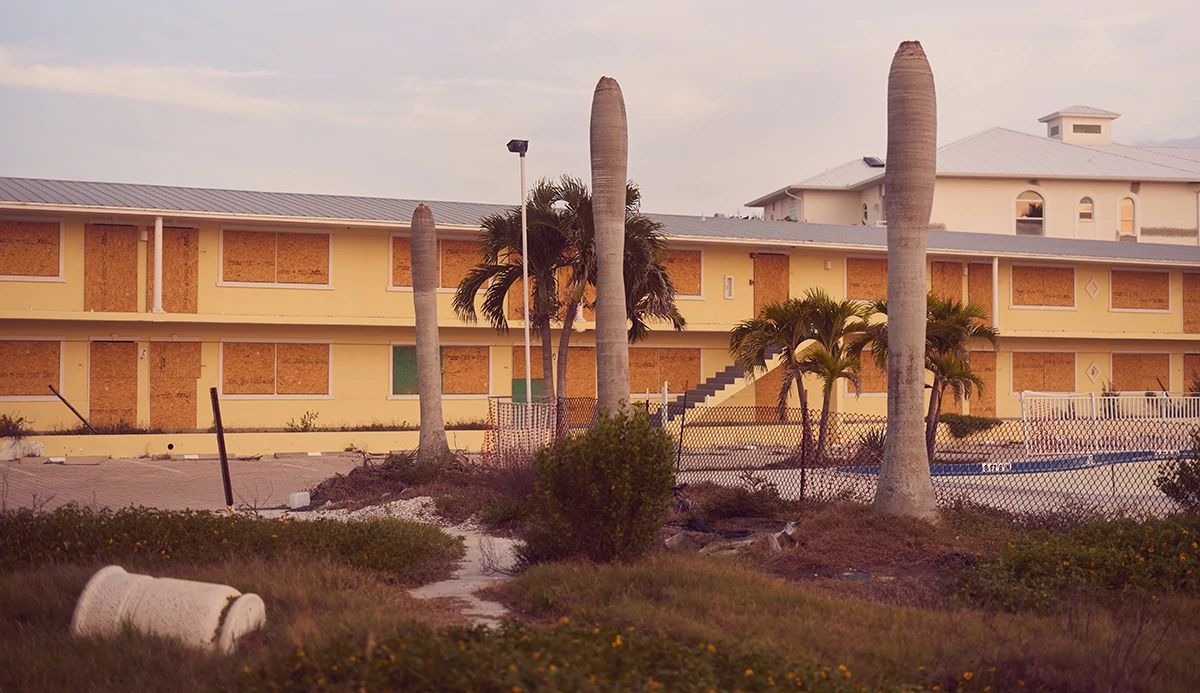
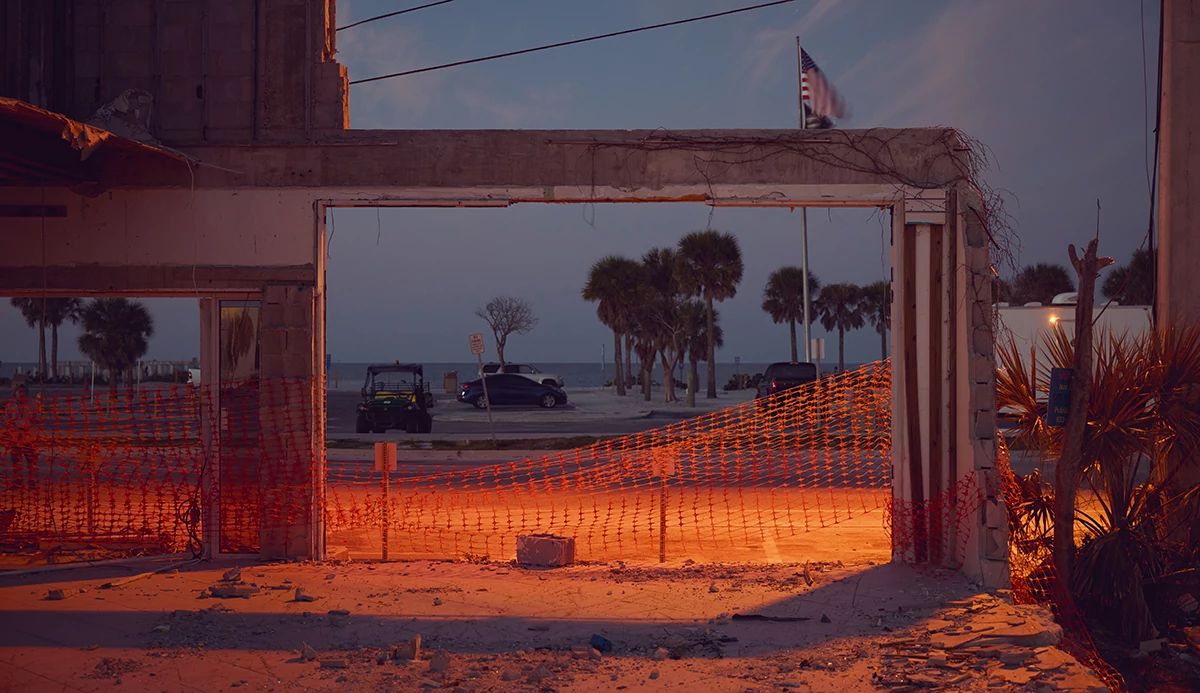
Hurricane damage at the Neptune Resort and a retail space at Times Square in March, Fort Myers Beach
In the meantime, at least nine homeowners insurance companies in Florida have gone belly-up or left the state in recent years. By Ian’s one-year anniversary, those that remained had declined roughly 29 percent of claims.
And while Jody Stewart’s New Jersey neighborhood is currently booming, credit ratings agency Moody’s projects that the largest population losses due to climate change over the next 30 years will occur in these five states: Arizona, Delaware, South Carolina, New Jersey and Florida. At some point, in other words, the bubble will burst, and there’s no telling when that will be.
Rather than wrestle with hard choices regarding how, and even whether, to rebuild, many policymakers focus on short-term recovery.
International efforts to limit greenhouse gases might potentially slow future sea level rise, but they can’t reverse what is already happening. And at the local level, the construction of new drainage systems and barriers to protect coastal communities comes at a cost — and with no guarantees. In Salisbury Beach, Massachusetts, in March, a group of property owners pooled their money and spent some $565,000 to build a high sand barrier between themselves and the sea. A few days and one storm later, the 1.5-mile-long man-made dune was flattened.
Rather than wrestle with hard choices regarding how, and even whether, to rebuild homes and infrastructure to withstand rising tides, though, many policymakers focus on short-term recovery. And while Savarese believes the need for long-term planning is urgent, he says he understands the leaders’ focus on recovery. “They are admittedly in a rush to put things back together,” he says. “Their economies are suffering; people have lost property and loved ones.”
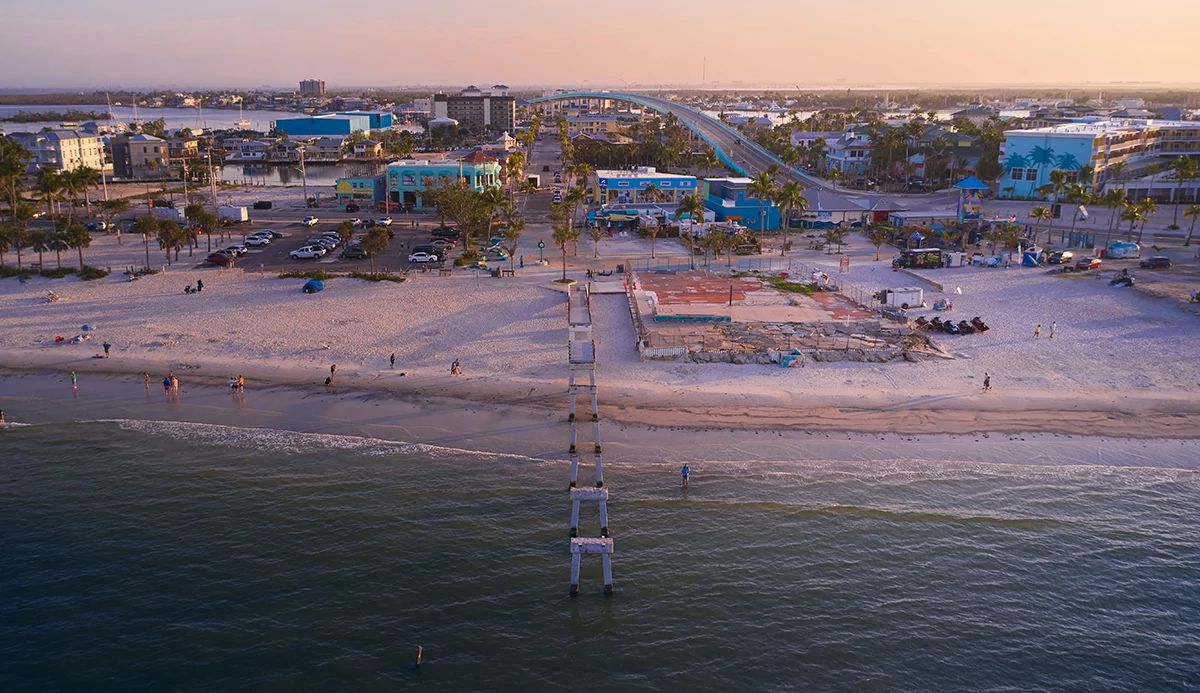
The Fort Myers Beach Fishing Pier and damaged waterfront, as seen from the Gulf of Mexico
Among people who know the costs and risks of living near the shore, many are willing to bear them. At the shelter, when Martha Shaw came out of her funk and weighed her options, she decided to make her way home. What good was having saved her whole life, after all, if she didn’t use what she’d socked away to get back on her feet?
“I prayed and prayed and prayed,” she says. Then she secured a special hurricane-victim low-interest U.S. Small Business Administration loan, found a contractor and took steps to start rebuilding. A real estate agent found her a temporary rental 12 miles north of her razed mobile home.
We visited in the tiny living room of the rental, a boxy cottage across from an assisted living center on a street with no sidewalks. The place had come furnished and Shaw, with biting humor, started introducing me to the items that weren’t hers, which, it turned out, was almost all of them. She loves the sun, but we sat with the shades drawn because the drafty windows let out too much cold air, and Shaw was worried about money.
It hasn’t been an easy road. Her rental is in a part of town she barely knows. Her neighbors are nice but pretty quiet, and given her mobility issues and temporary status, she has struggled to forge strong bonds with anybody. Her driveway, dusted with gravel near the road, makes collecting the mail feel a bit treacherous. It’s why she decided not to get a newspaper delivered.

Shaw and her dog, Andre, in front of her nearly completed new home, on pillars at the site of her previous house
Shaw misses gazing out at the pink and white flowering plumeria trees that once towered above her old home. She longs for the daily company of her old neighborhood pals. And she misses an old feeling: not worrying about money. In addition to building a new house on cement columns, she had to pay truckers to haul off post-storm garbage and she is paying to keep her lot mowed. Still to come: shopping for replacement furniture.
“I’m literally losing hair,” she told me, laughing. “And that’s nothing but stress and worry.”
Near the end of our visit, Shaw said that just one week before the storm hit, she had installed her last hurricane window — the 11th, in her mobile home’s sunroom — “and I paid them in cash,” she said, conspiratorially. I found that so maddening and ridiculous, given what she’d been through, that I laughed. And then I apologized.
Once again, Shaw waved off my apology.
Smiling, she said, “I mean, I laughed, too.”
Epilogue: We checked in with Shaw again in late September, shortly after Hurricane Helene passed through Fort Myers. By then, she had moved into her rebuilt home on pillars, where she and her poodle, Andre, rode out the storm. Muddy water filled her neighbors’ lots, but Shaw stayed dry nearly 12 feet off the ground. She says her heart goes out to those dealing with the devastating floods the storm left in its wake. No one should worry about her, though. “I’m in my own house. I’ve got my own things,” she says. “I’m just as happy as a clam.”
Craig Welch has been reporting on the environment and climate change for more than a quarter century, including eight years with National Geographic. A former fellow with the Nieman Foundation for Journalism at Harvard University, he lives with his family in Seattle.
More From AARP



